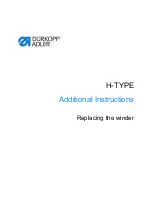Reviews:
No comments
Related manuals for 885-V12

MC 300E -
Brand: Janome Pages: 31

FS50 B
Brand: Fimap Pages: 19

3300SD
Brand: Reliable Pages: 44

Memory Craft 3500
Brand: Janome Pages: 31

KK-STF-480
Brand: KISANKRAFT Pages: 14

SEW E-Z W338
Brand: White Pages: 12

410W110
Brand: Singer Pages: 7

Blizzard 1200
Brand: Malanbao Pages: 6

56384165
Brand: Nilfisk-Advance Pages: 48

56396000
Brand: Nilfisk-Advance Pages: 70

753U 200
Brand: Singer Pages: 33

Cyclone CR38
Brand: cimex Pages: 19

H-TYPE CLASSIC
Brand: DURKOPP ADLER Pages: 18

DDL-5600N Series
Brand: JUKI Pages: 48

Crescendo Quilting & Sewing Machine
Brand: Baby Lock Pages: 2

LSM500ASTRO
Brand: Ibiza Pages: 19

MO-104DN
Brand: JUKI Pages: 32

M-1 Series
Brand: JUKI Pages: 15

















